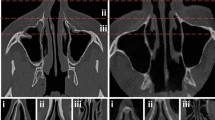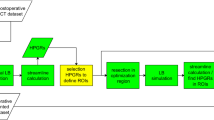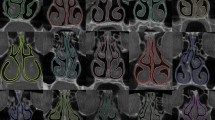Abstract
Purpose
Surgery for nasal airway obstruction (NAO) has a high failure rate, with up to 50% of patients reporting persistent symptoms postoperatively. Virtual surgery planning has the potential to improve surgical outcomes, but current manual methods are too labor-intensive to be adopted on a large scale. This manuscript introduces an automatic atlas-based approach for performing virtual septoplasties.
Methods
A cohort of 47 healthy subjects and 26 NAO patients was investigated. An atlas of healthy nasal geometry was constructed. The automatic virtual septoplasty method consists of a multi-stage registration approach to fit the atlas to a target NAO patient, automatically segment the patient’s septum and airway, and deform the patient image to have a non-deviated septum.
Results
Our automatic virtual septoplasty method straightened the septum successfully in 18 out of 26 NAO patients (69% of cases). In these cases, the ratio of the higher to the lower airspace cross-sectional areas in the left and right nasal cavities improved from 1.47 ± 0.45 to 1.16 ± 0.33 in the region surrounding the septal deviation, showing that the nasal airway became more symmetric after virtual septoplasty.
Conclusion
This automated virtual septoplasty technique has the potential to greatly reduce the effort required to perform computational fluid dynamics (CFD) analysis of nasal airflow for NAO surgical planning. Future studies are needed to investigate if virtual surgery planning using this method is predictive of subjective symptoms in NAO patients after septoplasty.






Similar content being viewed by others
Data availability
The data used in this study are not publicly available.
Code availability
The code used to complete this study is not publicly available but was built upon open-source toolkits, primarily ITK, 3D Slicer, and Elastix. The Elastix configuration files used for the various registration steps are available at [29].
References
Manoukian PD, Wyatt JR, Leopold DA, Bass EB (1997) Recent trends in utilization of procedures in otolaryngology-head and neck surgery. Laryngoscope 107:472–477
Bhattacharyya N (2010) Ambulatory sinus and nasal surgery in the United States: demographics and perioperative outcomes. Laryngoscope 120:635–638
Holmstrom M (2010) The use of objective measures in selecting patients for septal surgery. Rhinology 48:387–393
Andre RF, Vuyk HD, Ahmed A, Graamans K, Nolst Trenite GJ (2009) Correlation between subjective and objective evaluation of the nasal airway. A systematic review of the highest level of evidence. Clin Otolaryngol 34:518–525
Dinis PB, Haider H (2002) Septoplasty: long-term evaluation of results. Am J Otolaryngol 23:85–90
Ho WK, Yuen AP, Tang KC, Wei WI, Lam PK (2004) Time course in the relief of nasal blockage after septal and turbinate surgery: a prospective study. Arch Otolaryngol Head Neck Surg 130:324–328
Jessen M, Ivarsson A, Malm L (1989) Nasal airway resistance and symptoms after functional septoplasty: comparison of findings at 9 months and 9 years. Clin Otolaryngol Allied Sci 14:231–234
Sundh C, Sunnergren O (2015) Long-term symptom relief after septoplasty. Eur Arch Otorhinolaryngol 272:2871–2875
Moghaddam MG, Garcia GJM, Frank-Ito DO, Kimbell JS, Rhee JS (2020) Virtual septoplasty: a method to predict surgical outcomes for patients with nasal airway obstruction. Int J Comput Assist Radiol Surg 15:725–735
Sanmiguel-Rojas E, Burgos MA, Esteban-Ortega F (2018) Nasal surgery handled by CFD tools. Int J Numer Method Biomed Eng 34:e3126
Vanhille DL, Garcia GJM, Asan O, Borojeni AAT, Frank-Ito DO, Kimbell JS, Pawar SS, Rhee JS (2018) Virtual surgery for the nasal airway: a preliminary report on decision support and technology acceptance. JAMA Facial Plast Surg 20:63–69
Frank-Ito DO, Kimbell JS, Borojeni AAT, Garcia GJM, Rhee JS (2019) A hierarchical stepwise approach to evaluate nasal patency after virtual surgery for nasal airway obstruction. Clin Biomech (Bristol, Avon) 61:172–180
Hariri BM, Rhee JS, Garcia GJ (2015) Identifying patients who may benefit from inferior turbinate reduction using computer simulations. Laryngoscope 125:2635–2641
Lee HP, Garlapati RR, Chong VF, de Wang Y (2013) Comparison between effects of various partial inferior turbinectomy options on nasal airflow: a computer simulation study. Comput Methods Biomech Biomed Eng 16:112–118
Lee TS, Goyal P, Li C, Zhao K (2018) Computational fluid dynamics to evaluate the effectiveness of inferior turbinate reduction techniques to improve nasal airflow. JAMA Facial Plast Surg 20:263–270
Na Y, Chung KS, Chung SK, Kim SK (2012) Effects of single-sided inferior turbinectomy on nasal function and airflow characteristics. Respir Physiol Neurobiol 180:289–297
Simmen D, Sommer F, Briner HR, Jones N, Kroger R, Hoffmann TK, Lindemann J (2015) The effect of “Pyriform Turbinoplasty” on nasal airflow using a virtual model. Rhinology 53:242–248
Wexler D, Segal R, Kimbell J (2005) Aerodynamic effects of inferior turbinate reduction: computational fluid dynamics simulation. Arch Otolaryngol Head Neck Surg 131:1102–1107
Hemtiwakorn K, Mahasitthiwat V, Tungjitkusolmun S, Hamamoto K, Pintavirooj C (2015) Patient-specific aided surgery approach of deviated nasal septum using computational fluid dynamics. IEEJ Trans Electr Electron Eng 10:274–286
Burgos MA, Sanmiguel-Rojas E, Singh N, Esteban-Ortega F (2018) DigBody((R)): a new 3D modeling tool for nasal virtual surgery. Comput Biol Med 98:118–125
Garcia GJ, Rhee JS, Senior BA, Kimbell JS (2010) Septal deviation and nasal resistance: an investigation using virtual surgery and computational fluid dynamics. Am J Rhinol Allergy 24:e46-53
Campbell DA, Moghaddam MG, Rhee JS, Garcia GJM (2020) Narrowed posterior nasal airway limits efficacy of anterior septoplasty. Facial Plast Surg Aesthet Med. https://doi.org/10.1089/fpsam.2020.0081
Keustermans W, Huysmans T, Danckaers F, Zarowski A, Schmelzer B, Sijbers J, Dirckx JJ (2018) High quality statistical shape modelling of the human nasal cavity and applications. R Soc Open Sci 5(12):181558
Borojeni AA, Garcia GJ, Moghaddam MG, Frank-Ito DO, Kimbell JS, Laud PW et al (2020) Normative ranges of nasal airflow variables in healthy adults. Int J Comput Assist Radiol Surg 15(1):87–98
Hildebrandt T, Bruening JJ, Lamecker H, Zachow S, Heppt WJ, Schmidt N, Goubergrits L (2019) Digital analysis of nasal airflow facilitating decision support in rhinosurgery. Facial Plast Surg 35(01):003–008
Stewart MG, Witsell DL, Smith TL, Weaver EM, Yueh B, Hannley MT (2004) Development and validation of the nasal obstruction symptom evaluation (NOSE) scale. Otolaryngol Head Neck Surg 130(2):157–163
Klein S, Staring M, Murphy K, Viergever MA, Pluim JP (2009) Elastix: a toolbox for intensity-based medical image registration. IEEE Trans Med Imaging 29(1):196–205
Shamonin DP, Bron EE, Lelieveldt BP, Smits M, Klein S, Staring M (2014) Fast parallel image registration on CPU and GPU for diagnostic classification of Alzheimer’s disease. Front Neuroinform 7:50
http://elastix.bigr.nl/wiki/index.php/Parameter_file_database
Clipp RB, Vicory J, Horvath S, Mitran S, Kimbell JS, Rhee JS, Enquobahrie A (2018) An interactive, patient-specific virtual surgical planning system for upper airway obstruction treatments. In: 2018 40th annual international conference of the IEEE engineering in medicine and biology society (EMBC). IEEE, pp 5802–5805
Eccles R (2000) Nasal airflow in health and disease. Acta Oto-laryngol 120(5):580–595
Gaberino C, Rhee JS, Garcia GJM (2017) Estimates of nasal airflow at the nasal cycle mid-point improve the correlation between objective and subjective measures of nasal patency. Respir Physiol Neurobiol 238:23–32
Patel RG, Garcia GJM, Frank-Ito DO, Kimbell JS, Rhee JS (2015) Simulating the nasal cycle with computational fluid dynamics. Otolaryngol Head Neck Surg 152:353–360
Kimbell JS, Garcia GJM, Frank DO, Cannon DE, Pawar SS, Rhee JS (2012) Computed nasal resistance compared with patient-reported symptoms in surgically treated nasal airway passages. Am J Rhinol Allergy 26:e94–e98
Sullivan CD, Garcia GJM, Frank DO, Kimbell JS, Rhee JS (2014) Perception of better nasal patency correlates with increased mucosal cooling after surgery for nasal obstruction. Otolaryngol Head Neck Surg 150:139–147
Casey KP, Borojeni AAT, Koenig LJ, Rhee JS, Garcia GJM (2017) Correlation between subjective nasal patency and intranasal airflow distribution. Otolaryngol Head Neck Surgery 156:741–750
Kim SK, Heo GE, Seo A, Na Y, Chung S-K (2014) Correlation between nasal airflow characteristics and clinical relevance of nasal septal deviation to nasal airway obstruction. Respir Physiol Neurobiol 192:95–101
Funding
This work was supported by NIH R44 EB023121.
Author information
Authors and Affiliations
Corresponding author
Ethics declarations
Conflict of interest
The authors have no conflicts of interest to declare.
Ethical approval
This study was approved by the Institutional Review Board at the Medical College of Wisconsin.
Informed consent
Informed consent was obtained from all individuals whose data were used in this study.
Additional information
Publisher's Note
Springer Nature remains neutral with regard to jurisdictional claims in published maps and institutional affiliations.
Rights and permissions
About this article
Cite this article
Vicory, J., Garcia, G.J.M., Rhee, J.S. et al. Toward automatic atlas-based surgical planning for septoplasty. Int J CARS 17, 403–411 (2022). https://doi.org/10.1007/s11548-021-02524-9
Received:
Accepted:
Published:
Issue Date:
DOI: https://doi.org/10.1007/s11548-021-02524-9




